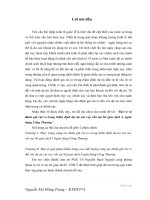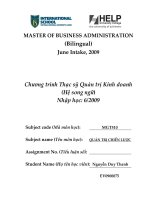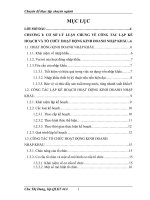ISA 6 lập kế hoạch và đánh giá rủi ro kinh doanh
Bạn đang xem bản rút gọn của tài liệu. Xem và tải ngay bản đầy đủ của tài liệu tại đây (807.75 KB, 41 trang )
Chapter 6
Planning, Knowledge of
the Business and
Evaluating Business Risk
Copyright 2006 McGraw-Hill Australia Pty Ltd
6-1
Learning Objective 1:
Client Acceptance
Copyright 2006 McGraw-Hill Australia Pty Ltd
Revised PPTs t/a Auditing and Assurance Services in Australia 3e by Grant Gay and Roger Simnett
Slides prepared by Roger Simnett
6-2
Acceptance and continuance evaluation
procedures
•
Procedures carried out before accepting a new client or
continuing with an existing client include:
– Reviewing financial information regarding the client;
– Making inquiries of third parties such as solicitors and
bankers;
– Communicating with previous auditor;
– Ensuring that the firm has technical expertise to carry out
audit; and
– Ensuring accepting engagement will not conflict with the
profession’s code of professional conduct.
Copyright 2006 McGraw-Hill Australia Pty Ltd
Revised PPTs t/a Auditing and Assurance Services in Australia 3e by Grant Gay and Roger Simnett
Slides prepared by Roger Simnett
6-3
Communication with previous auditor
•
•
•
•
Communication ensures that the interests of shareholders,
the incoming auditor and existing auditor are protected. It
allows the existing auditor to advise the prospective auditor of
any professional matters they should be aware of before
accepting the engagement.
Nominated incoming auditor should request client’s
permission to communicate with previous auditor;
If client refuses permission, normally decline nomination; and
If permission is granted, the nominated auditor asks previous
auditor for all information necessary to decide whether
nomination should be accepted.
Copyright 2006 McGraw-Hill Australia Pty Ltd
Revised PPTs t/a Auditing and Assurance Services in Australia 3e by Grant Gay and Roger Simnett
Slides prepared by Roger Simnett
6-4
Learning Objective 2:
Engagement Letters
•
These letters are from the auditor to the client that document
the arrangements and confirm the auditor’s acceptance of
the appointment and should include:
– Objectives and scope of audit;
– Responsibility of management for financial report;
– Form of any reports;
– An explanation of the extent to which an audit can be
relied upon to detect material misstatement; and
– Auditor’s right of unrestricted access to records,
documents
and other information necessary to
complete audit.
Copyright 2006 McGraw-Hill Australia Pty Ltd
Revised PPTs t/a Auditing and Assurance Services in Australia 3e by Grant Gay and Roger Simnett
Slides prepared by Roger Simnett
6-5
Learning Objective 3:
Audit Planning
•
The planning stage is a very important stage of the audit and
involves two aspects:
– Audit plan - outlines the expected scope and conduct of
audit; and
– Audit program - directs the nature, timing and extent of
audit procedures.
Copyright 2006 McGraw-Hill Australia Pty Ltd
Revised PPTs t/a Auditing and Assurance Services in Australia 3e by Grant Gay and Roger Simnett
Slides prepared by Roger Simnett
6-6
Major steps in the audit process
•
In every audit of a financial report there are seven identifiable
stages. These stages are:
– Obtaining knowledge of the client’s business;
– Understanding internal controls;
– Assessing risks of material misstatement;
– Responses to assessed risks;
– Performing tests of controls;
– Performing substantive procedures; and
– Completion and review.
Copyright 2006 McGraw-Hill Australia Pty Ltd
Revised PPTs t/a Auditing and Assurance Services in Australia 3e by Grant Gay and Roger Simnett
Slides prepared by Roger Simnett
6-7
Learning Objective 4:
Developing an Overall Audit Strategy
•
•
•
Overall audit strategy details the general evidence
requirements for forming an opinion and initial decision as to
the nature, timing and extent of audit procedures.
Interrelationship between materiality, audit risk and what
constitutes sufficient appropriate audit evidence impacts on
auditor’s strategy.
Audit strategies can range from a lower assessed level of
control risk approach to a predominantly substantive
approach.
Copyright 2006 McGraw-Hill Australia Pty Ltd
Revised PPTs t/a Auditing and Assurance Services in Australia 3e by Grant Gay and Roger Simnett
Slides prepared by Roger Simnett
6-8
Range of audit strategies
Lower assessed
level of
control risk
Predominantly
substantive
approach
Audit strategy may be anywhere along this continuum
Copyright 2006 McGraw-Hill Australia Pty Ltd
Revised PPTs t/a Auditing and Assurance Services in Australia 3e by Grant Gay and Roger Simnett
Slides prepared by Roger Simnett
6-9
Lower assessed level of control risk
approach
•
If internal control is well designed and expected to be highly
effective, audit strategy will include:
– Low or medium assessed level of control risks;
– Extensive understanding of relevant parts of internal
control;
– Extensive tests of control; and
– Reduced level of substantive audit procedures, based on
planned acceptable level of detection risk being high or
medium.
Copyright 2006 McGraw-Hill Australia Pty Ltd
Revised PPTs t/a Auditing and Assurance Services in Australia 3e by Grant Gay and Roger Simnett
Slides prepared by Roger Simnett
6-10
Predominantly substantive approach
•
If the auditor believes adequate controls do not exist or might
be ineffective or testing controls are not cost effective, audit
strategy will be to:
– Use a planned assessed level of control risk of high;
– Plan to obtain a minimum understanding of internal
control;
– Plan no tests of control; and
– Plan extensive substantive audit procedures based on
planned acceptable level of detection risk of low or
medium.
Copyright 2006 McGraw-Hill Australia Pty Ltd
Revised PPTs t/a Auditing and Assurance Services in Australia 3e by Grant Gay and Roger Simnett
Slides prepared by Roger Simnett
6-11
Impact of business risk assessment on
audit strategy
•
Substantial time is spent on the planning stage and on
developing an expectation of what the entity’s financial report
should look like. Audit strategy might include:
– Increased use of sophisticated analytical procedures;
– Undertaking tests of controls for routine transactions;
– Increased substantive testing for non-routine
transactions; and
– Reduced detailed substantive testing if financial report is
in accordance with auditor’s expectations.
Copyright 2006 McGraw-Hill Australia Pty Ltd
Revised PPTs t/a Auditing and Assurance Services in Australia 3e by Grant Gay and Roger Simnett
Slides prepared by Roger Simnett
6-12
Preparing detailed audit programs
•
An audit program is a detailed list of audit procedures that
need to be applied to a particular balance or class of
transactions to implement the audit strategy.
Copyright 2006 McGraw-Hill Australia Pty Ltd
Revised PPTs t/a Auditing and Assurance Services in Australia 3e by Grant Gay and Roger Simnett
Slides prepared by Roger Simnett
6-13
Purpose of detailed audit programs
•
Programs should provide:
– Evidence of proper planning of work;
– Guidance for inexperienced staff;
– Evidence of work performed;
– A means of controlling time spent on the engagement;
and
– Evidence of consideration of internal control structure in
relation to proposed audit procedures.
Copyright 2006 McGraw-Hill Australia Pty Ltd
Revised PPTs t/a Auditing and Assurance Services in Australia 3e by Grant Gay and Roger Simnett
Slides prepared by Roger Simnett
6-14
Contents of audit program
•
An audit program will outline the following characteristics of
audit procedures:
– Nature - particular audit procedures to use and particular
items to which a procedure will be applied;
– Extent - number of items to which procedures will be
applied, and number of different tests to be performed;
and
– Timing - appropriate time to perform the procedure.
Copyright 2006 McGraw-Hill Australia Pty Ltd
Revised PPTs t/a Auditing and Assurance Services in Australia 3e by Grant Gay and Roger Simnett
Slides prepared by Roger Simnett
6-15
Learning Objective 5:
Assigning and Scheduling Audit Staff
•
Activities entailed include:
– Coordinating assistance of client entity personnel;
– Determining the extent of involvement of consultants,
specialists and internal auditors; and
– Establishing and co-ordinating staffing requirements.
Copyright 2006 McGraw-Hill Australia Pty Ltd
Revised PPTs t/a Auditing and Assurance Services in Australia 3e by Grant Gay and Roger Simnett
Slides prepared by Roger Simnett
6-16
Learning Objective 6:
Knowledge of the Client’s Business
•
Purpose – help to assess business risk, assist the auditor to
identify events, transactions, practices and risks that might
have a significant effect on financial report, particularly on the
appropriateness of accounting policies adopted and the
reasonableness of assumptions and estimates incorporated
in client’s financial report.
Copyright 2006 McGraw-Hill Australia Pty Ltd
Revised PPTs t/a Auditing and Assurance Services in Australia 3e by Grant Gay and Roger Simnett
Slides prepared by Roger Simnett
6-17
Procedures for obtaining an
understanding of a client’s business
•
These include:
– Reviewing the auditor’s previous experience with the
client and industry;
– Discussion with client personnel, other advisers or
previous auditors of the entity;
– Reviewing the industry or government publications and
legislations;
– Visiting the client’s premises; and
– Reviewing documentation produced by the client.
Copyright 2006 McGraw-Hill Australia Pty Ltd
Revised PPTs t/a Auditing and Assurance Services in Australia 3e by Grant Gay and Roger Simnett
Slides prepared by Roger Simnett
6-18
Steps in planning the audit
Copyright 2006 McGraw-Hill Australia Pty Ltd
Revised PPTs t/a Auditing and Assurance Services in Australia 3e by Grant Gay and Roger Simnett
Slides prepared by Roger Simnett
6-19
Knowledge obtained by the auditor
•
An auditor should obtain an understanding of:
–
Client’s organisational structure;
–
Client’s operational and legal structure; and
–
Relevant industry and economic conditions.
Copyright 2006 McGraw-Hill Australia Pty Ltd
Revised PPTs t/a Auditing and Assurance Services in Australia 3e by Grant Gay and Roger Simnett
Slides prepared by Roger Simnett
6-20
Learning Objective 7:
Business Risk
•
Business risk can be defined as:
– Risk that an entity’s business objectives will not be
attained as a result of external and internal forces brought
to bear on an entity and, ultimately, the risk associated
with the entity’s profitability and survival.
Copyright 2006 McGraw-Hill Australia Pty Ltd
Revised PPTs t/a Auditing and Assurance Services in Australia 3e by Grant Gay and Roger Simnett
Slides prepared by Roger Simnett
6-21
The relationship between client business risk
and the global, local and internal
environments
Copyright 2006 McGraw-Hill Australia Pty Ltd
Revised PPTs t/a Auditing and Assurance Services in Australia 3e by Grant Gay and Roger Simnett
Slides prepared by Roger Simnett
6-22
Assessing business risk
•
The auditor must obtain a thorough understanding of the
industry, including:
– Profitability and structure of the industry;
– Relationship between the industry and the broad
economic and business environment;
– Critical issues facing the industry; and
– Significant industry business risks.
Copyright 2006 McGraw-Hill Australia Pty Ltd
Revised PPTs t/a Auditing and Assurance Services in Australia 3e by Grant Gay and Roger Simnett
Slides prepared by Roger Simnett
6-23
Assessing business risk (cont.)
•
The auditor must also understand how the entity fits within
the industry, including:
– Entity’s position within the industry in terms of profitability
and market share;
– Opportunities and plans the entity has for increasing or
maintaining profitability and market share;
– Threats to the entity’s position in the industry;
– Ways in which the entity deals with customers and
competitors; and
– Methods the entity uses to measure and monitor its
performance.
Copyright 2006 McGraw-Hill Australia Pty Ltd
Revised PPTs t/a Auditing and Assurance Services in Australia 3e by Grant Gay and Roger Simnett
Slides prepared by Roger Simnett
6-24
Overview of the audit risk standards
Perform risk assessment procedures to understand the
entity and its environment.
See AUS 402.06-99/
ASA 315.10-116
(ISA 315.06-99)
Assess the risks of material misstatement at the
financial report level and at assertion level.
See AUS 402.100-119/
ASA 315.117-140
(ISA 315.100-119)
Respond to the risks at the financial report level and
assertion level.
See AUS 406.04-21/
ASA 330.08-28
(ISA 330.04-21)
Perform further audit procedures that are clearly linked
to risks at the assertion level.
See AUS 406.22-65/
ASA 330.29-89
(ISA 330.22-65)
Evaluate whether sufficient and appropriate audit
evidence has been obtained.
See AUS 406.66-72/
ASA 330.90-98
(ISA 330.66-72)
and AUS 502/ ASA 500
(ISA 500)
Copyright 2006 McGraw-Hill Australia Pty Ltd
Revised PPTs t/a Auditing and Assurance Services in Australia 3e by Grant Gay and Roger Simnett
Slides prepared by Roger Simnett
6-25









